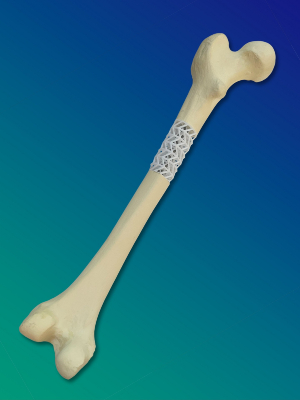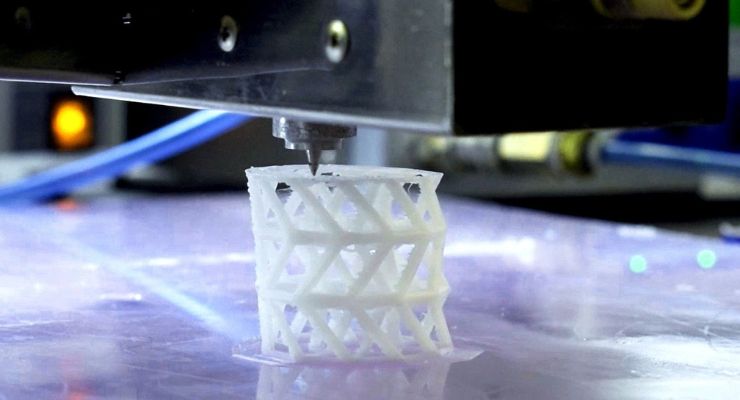Sam Brusco, Associate Editor11.13.23
Fraunhofer researchers have worked with partners to develop a composite material for use in non-union bone breaks. The resulting implant is designed to improve treatment success rates and speed the healing process.
Fraunhofer IFAM researchers build a composite material from the biodegradable polymer polycaprolactone (PCL) and bioactive glass, which is then 3D printed into a customized scaffold for bone fracture sites after a CT scan of the damaged bone. The implant replaces the missing bone part and is then filled with bone marrow.
“The bioactive glass in the scaffold raises the pH of its surroundings to alkaline. The next thing we want to investigate is the expected result of this, which is inhibiting bacteria growth,” Dr. Kai Borcherding, head of the Medical Technology and Life Sciences business unit at Fraunhofer IFAM, told the press.

It also supports new bone growth at the fracture site—the glass turns into hydroxylapatite, a substance very similar to bone.
“With bioactive glass, we can tackle the problems that clinics face—we can inhibit bacterial growth and provide effective support for bone healing. After six to seven years, the scaffold will be fully biodegraded and converted into bone,” said PD Dr. Tobias Großner, trauma surgeon and head of experimental trauma surgery at Heidelberg University Hospital.
Combining PCL on an industrial scale is new. The Fraunhofer researchers bound glass and PCL that can be used in additive manufacturing. Project partner BellaSeno prints the scaffold from this material using a 3D printer.
“We use 3D printing so that we can create each scaffold individually to fit the fracture site for each patient,” said Dr. Mohit Chhaya, managing director of BellaSeno and project coordinator.
The SCABAEGO project research team is already investigating the concept in vitro and in vivo with preclinical tests, working with Heidelberg University Hospital. While these are ongoing, the “recipe” for the composite is being optimized. The proportion of bioactive glass in the scaffold can range between 10-3%.
Fraunhofer IFAM will be presenting November 13-16 at the joint Fraunhofer-Gesellschaft booth at the COMPAMED medical engineering trade fair in Düsseldorf, Germany (Hall 8a, Booth G10) presenting an initial 3D-printed demonstrator.
The SCABAEGO project scaffold can be customized to fit any size of long bone. With the help of a CT scan of the bone, the scaffold can be tailor-made using 3D printing. Image courtesy of Fraunhofer IFAM.
Fraunhofer IFAM researchers build a composite material from the biodegradable polymer polycaprolactone (PCL) and bioactive glass, which is then 3D printed into a customized scaffold for bone fracture sites after a CT scan of the damaged bone. The implant replaces the missing bone part and is then filled with bone marrow.
“The bioactive glass in the scaffold raises the pH of its surroundings to alkaline. The next thing we want to investigate is the expected result of this, which is inhibiting bacteria growth,” Dr. Kai Borcherding, head of the Medical Technology and Life Sciences business unit at Fraunhofer IFAM, told the press.

The SCABAEGO project scaffold can be customized to fit any size of long bone. With the help of a CT scan of the bone, the scaffold can be tailor-made using 3D printing. Image courtesy of Fraunhofer IFAM.
“With bioactive glass, we can tackle the problems that clinics face—we can inhibit bacterial growth and provide effective support for bone healing. After six to seven years, the scaffold will be fully biodegraded and converted into bone,” said PD Dr. Tobias Großner, trauma surgeon and head of experimental trauma surgery at Heidelberg University Hospital.
Combining PCL on an industrial scale is new. The Fraunhofer researchers bound glass and PCL that can be used in additive manufacturing. Project partner BellaSeno prints the scaffold from this material using a 3D printer.
“We use 3D printing so that we can create each scaffold individually to fit the fracture site for each patient,” said Dr. Mohit Chhaya, managing director of BellaSeno and project coordinator.
The SCABAEGO project research team is already investigating the concept in vitro and in vivo with preclinical tests, working with Heidelberg University Hospital. While these are ongoing, the “recipe” for the composite is being optimized. The proportion of bioactive glass in the scaffold can range between 10-3%.
Fraunhofer IFAM will be presenting November 13-16 at the joint Fraunhofer-Gesellschaft booth at the COMPAMED medical engineering trade fair in Düsseldorf, Germany (Hall 8a, Booth G10) presenting an initial 3D-printed demonstrator.
The SCABAEGO project scaffold can be customized to fit any size of long bone. With the help of a CT scan of the bone, the scaffold can be tailor-made using 3D printing. Image courtesy of Fraunhofer IFAM.













